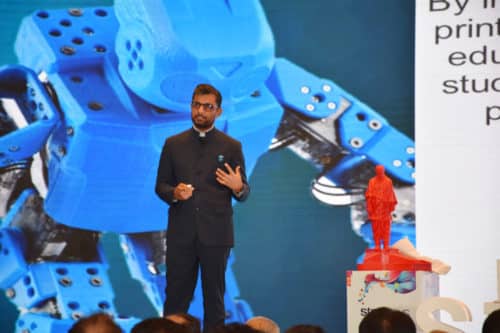3D printing has immense growth potential in India, but there is a lack of awareness of its diverse applications, says Rajiv Bajaj, managing director, India & SEA, Stratasys
Imagine a world with complete design freedom, where there are no manufacturing or assembly restrictions and you can have practically anything you want as a 3D model. With industries like manufacturing, automotive, aerospace, and defence, healthcare and education adapting 3D printing today, whatever we imagine would be a reality soon.
At the 2nd edition of Stratasys India User Forum 2018, key industry leaders and end-users exchanged insights on the latest 3D printing trends, applications, and best practices. They also discussed future businesses and present printing solutions for the constantly evolving market.

The event themed ‘Shaping what is Next’ was held in Bengaluru on December 18. The various trends discussed by the industry experts are as follows.
Main challenges
Be it solutions for enterprises or office, the main challenge today is in terms of design and the total cost of ownership. Another challenge faced today is developing a model with higher part realism and throughput with engineering grade materials.
“3D printing has immense growth potential in India, but the uptake has to be faster. We notice that there is a lack of awareness of the diverse applications of 3D Printing. Companies usually hold back on innovation due to ignorance of cost-benefit ratio, which if taken into consideration can help businesses deliver solutions faster, cheaper, better and easier. Stratasys India User Forum strives to bridge this gap and provide a platform for industry leaders to exchange knowledge and discuss the ever-changing dynamics of the industry,” said Rajiv Bajaj, managing director, India & SEA, Stratasys.
New methods of printing
While Fused Deposition Modelling (FDM) and Polyjet printing are the most used techniques of 3D printing today, a few more new methods with a unique value proposition for manufacturing are also coming up.
FDM: It is the most versatile technology for high-performance polymers and composites. They have the largest built sizes and go beyond two-meter cube in size. It is the most reliable and repeatable additive manufacturing technique being in use for the past 30 years.
LPM (layered Powder Metallurgy): LPM provides 80 per cent reduction in cost per part in aluminium. It provides highly simplified operational support by reducing the work hours from hours to minutes. It offers up to 9 times faster speed than lasers for aluminium with reduced post-processing. This technique can print auto gear transmission equipment, automotive oil pump housings, and engine brackets.
HSS (High-Speed Sintering): Stratasys in partnership with XAAR is working on another new technique called HSS that provides competitive economics to the normal injection moulding. This technique provides superior part quality due to XAAR’s proprietary jetting head and controls. It also can use a wide range of powders due to optimized print process. This technique can print better precision dental gum shields, shoe soles, and automotive manifolds.
3D printing in the Automotive sector
3D printing is playing an important role in smart manufacturing. Honda has included 3D printed thermoplastic car windshield mounts, headlight and trunk lid mounting structures in their recently manufactured models. This has reduced the weight of the structures by 30 percent and has increased the quality and the consistency.

Aerospace and Defence
When it comes to crucial applications like aerospace and defence in India, 3D printing is not behind. DRDO uses a snake-like robot developed using FDM and Polyjet printing to clean up the debris in the battlespace domestic area. This robot not just look like a snake, but it even does the cobra pose, crawls, rotates, and moves around like a snake in all the directions. This can also be used for rescue operation in times of natural calamities.
Healthcare
Though healthcare and 3D printing might sound irrelevant, but this technology is being widely used in this sector as well much like in other industries. Dr. Harider Singh Bedi, a medical stalwart from Shalby Hospital in Mohali, shared his experience on how 3D printing saved the life of a 23-year-old engineering student.
According to him, the patient’s Pulmonary AV malfunction was cured by developing the exact 3D replica of a tumour in lungs which helped the doctors understand the look of the tumour and perform the surgery better. 3D printing is also used in the medical field for surgical planning, research and education, organ printing and guided precise surgery. “With technologies like 3D printing, we are moving into a world of technology where even when a heart breaks a little, it won’t be hard to fix it,” says Dr. Harider Singh Bedi
Role of academia in leveraging 3D printing
With new technologies coming up, the skills required by an engineer now are far different from those of the past. NTTF along with Stratasys has developed 3D printing labs in all their centres to train students on the various techniques and processes of additive manufacturing. Researches are being conducted at the Centre for Incubation, Innovation, Research and Consultancy (CIIRC) on leveraging 3D printing in micro unmanned aerial vehicles.

“India is passing through a critical stage, while the industry and the government are at the crossroads, the academia is also confused about what to do. But by the end of 2023, the whole manufacturing industry will be in for a shock,” says Mr. Reguraj N, managing director – Nettur Technical Training Foundation (NTTF)
Future of 3D Printing
The future of 3D printing seems to be promising with Digital Manufacturing, which is going to shock the whole manufacturing industry with its capabilities. Complex and custom solutions can be developed, and the factories are going to become distributed by revamping the whole manufacturing process. Going at this pace, the 4D printing revolution is also not very far away.
“India is becoming a manufacturing hub for foreign investors. Stratasys aims to leverage this opportunity to promote the adoption of 3D printing as part of the next Industrial revolution that empowers both personal manufacturing and customization in products,” says Guy Yair, executive vice president, EMEA & APJ, Stratasys
The power of additive manufacturing, mainly 3D printing, has been huge since the beginning. Today, with a lot of new hammering technologies, the best is yet to come.






